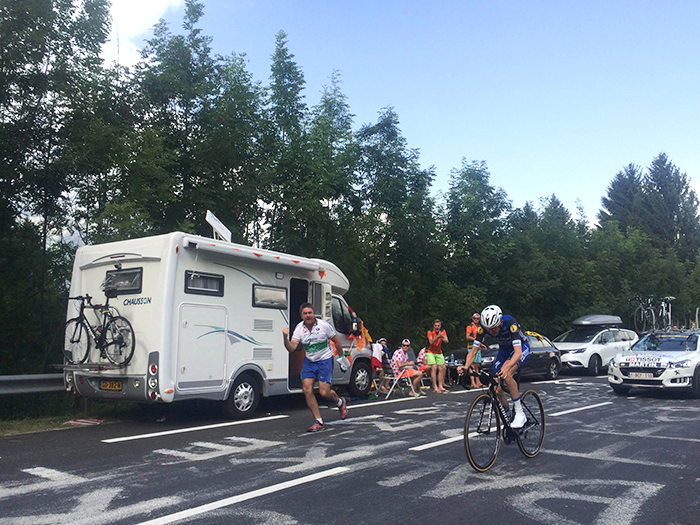Aside from their disastrous/cataclysmic failure to spot and remove a bollard from in front of a garage door on Stage 5, it’s hard to deny that, when it comes to road management, the organisers of La Vuelta did all they could to keep the riders from coming a cropper. On the steeper climbs especially, burly, boiler-suited young men kept crowds at bay, deterring any behaviour more energetic than polite applause as the riders grind past.
One effect of this was that the sight of “runners” - fans scampering alongside, behind or just ahead of riders - became a rare one, certainly more so than at either of this year’s other grand tours.
While many armchair/Twitter spectators and pundits, applauded the fans being kept in their place, not all did. The Cycling Podcast’s Richard Moore observed that the police were “slightly heavy-handed in dealing with spectators who encroached into riders racing line.”
I’d go even further. From the comfort of my living room, the Spanish Guardia Civil seemed, at times, to have more in common with American college campus police at a civil rights sit-in, than stewards of a simple sporting event.
Of course, I understand where it came from. The French laissez-faire approach to crowd management came in for a lot of criticism in July, particularly on Ventoux and in the incident that saw Chris Froome lamp a Carlos Valderama lookalike waving a flag perilously close to the lead group’s front wheels.
But as high profile as they might be, in reality these occasions are so rare, and the risk of incident so small as to be negligible. In my experience, the supporters that decide to run, rather than being inconsiderate idiots, do so having put a good amount of thought into how to do so without interfering with the race.
My single favourite memory of this year’s tour was watching a group of Irish chaps, wearing either Etixx jerseys or football kits, conducting a relay between themselves as Dan Martin went past on the second time trial. I spent a wonderful day in their company and while they had, indeed, partaken of a couple of Heineken while waiting for their hero, they had nonetheless planned the run with military precision. They watched as the other racers passed through our corner, carefully measuring how much room and time they would need so there would be not the slightest chance of getting in Martin’s way. They pulled it off to perfection, having bought themselves a few extra moments of entertainment and given me my favourite photo of the week (above). At no point was the rider in danger. Despite what many believe, this was not an act of narcissism, but one motivated by love for the sport and adoration for “yer man”.
One anecdote does not make a summer, of course, and this is not meant as a blanket defence of all who run. It is, however, intended to remind those who will unequivocally condemn that cycling fans are, on the whole, a good sort. Of course the racing must come first and be allowed to proceed without interruption but you're crazy if you think those on the roadside don't realise that too.
It can be easy to lose sight of how important the fans are to bike races but we are occasionally reminded when we see vacant roadsides, devoid of atmosphere or excitement. To crack down on fan behaviour risks deterring ordinary fans who, having spent who knows how many hours, travelled countless miles and spent god knows how much money, just want to have a bit of fun. They've waited for hours by the side of the road only for the race to pass by in a matter of seconds. Who would begrudge them a couple more?












